unit 5 meeting your ancestors listening and reading课件
文档属性
| 名称 | unit 5 meeting your ancestors listening and reading课件 |  | |
| 格式 | rar | ||
| 文件大小 | 1.4MB | ||
| 资源类型 | 教案 | ||
| 版本资源 | 人教版(新课程标准) | ||
| 科目 | 英语 | ||
| 更新时间 | 2010-08-16 06:15:00 | ||
图片预览

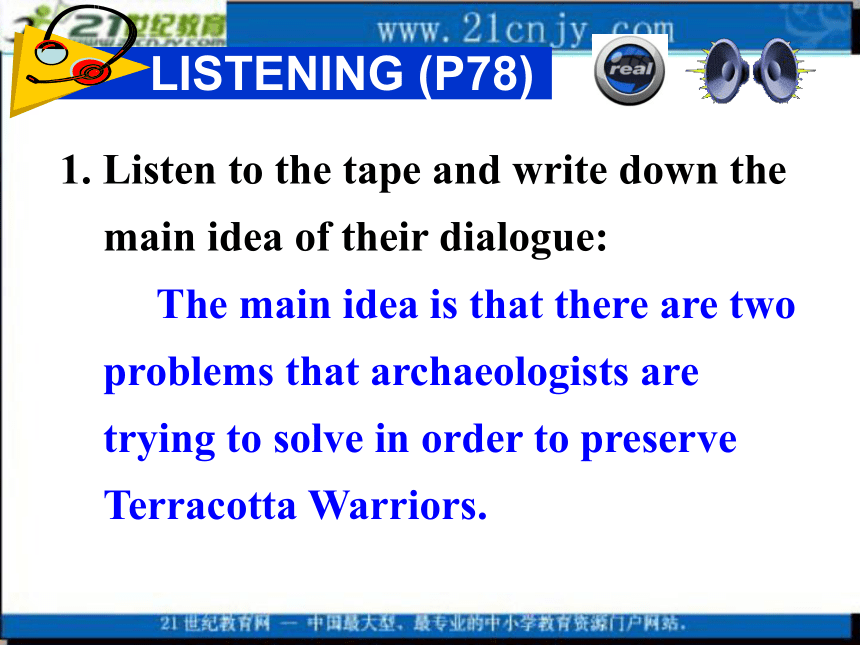
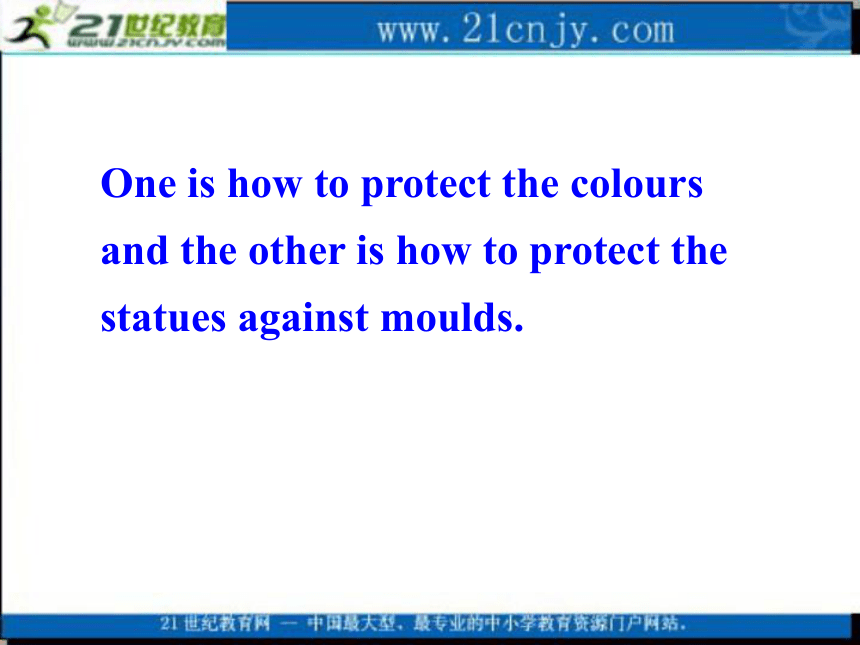

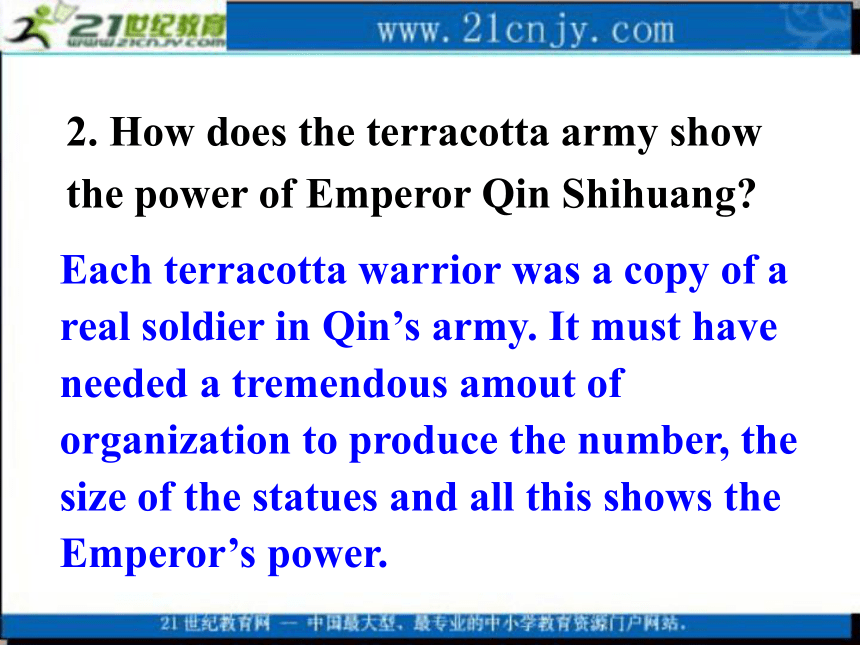
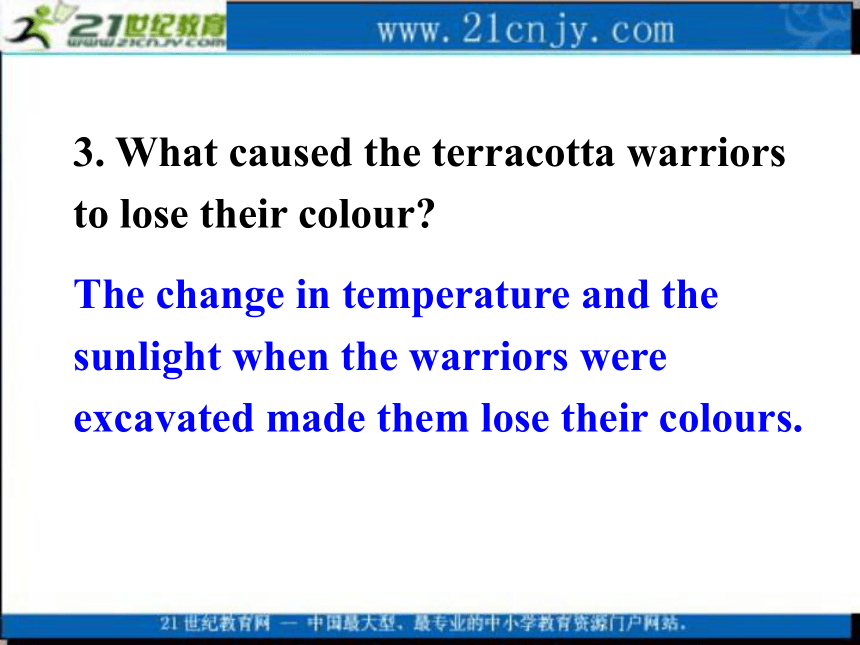
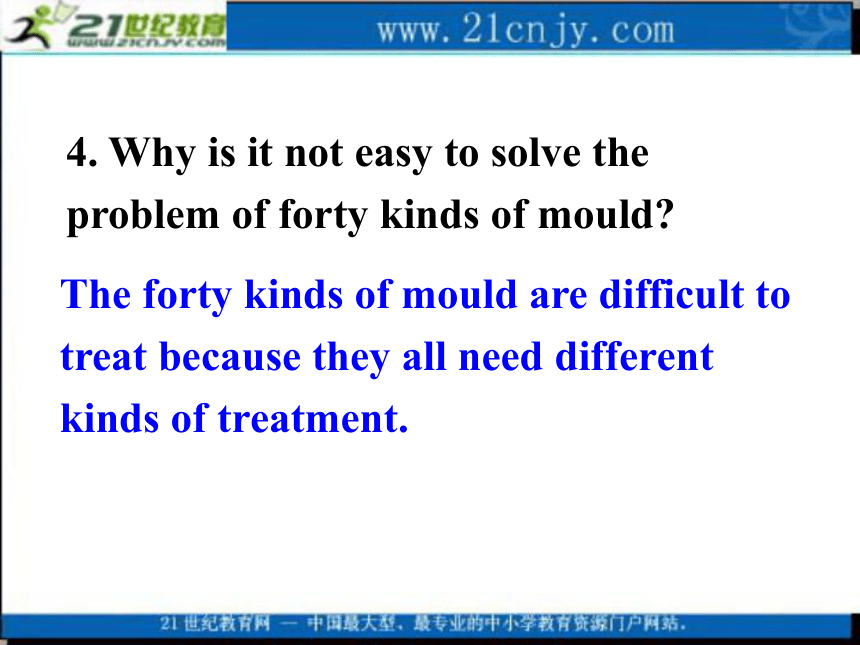
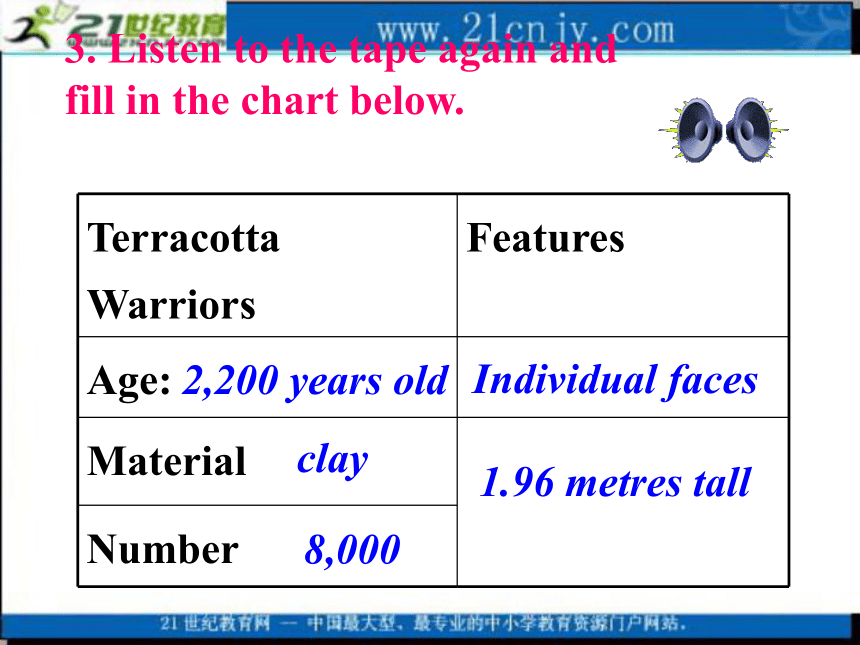
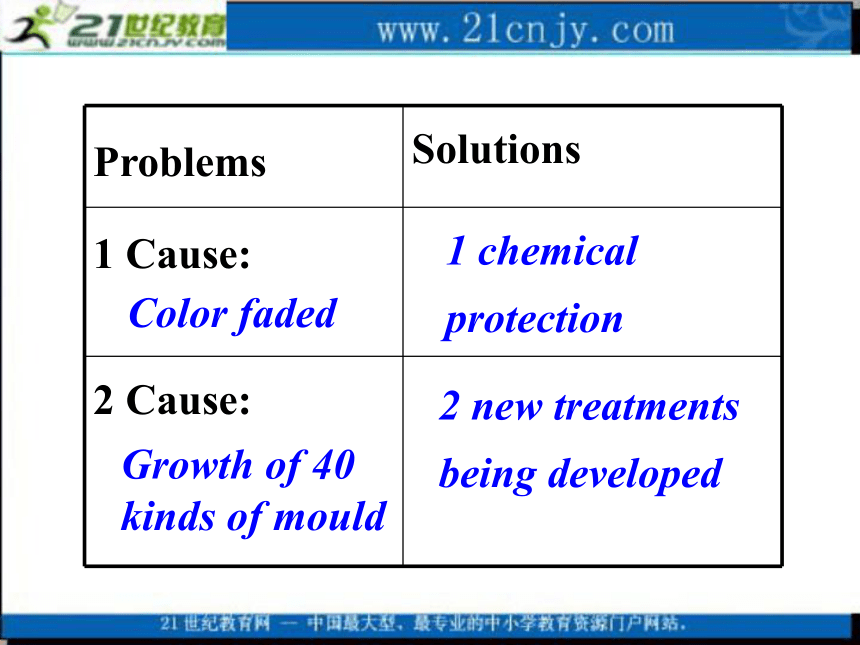

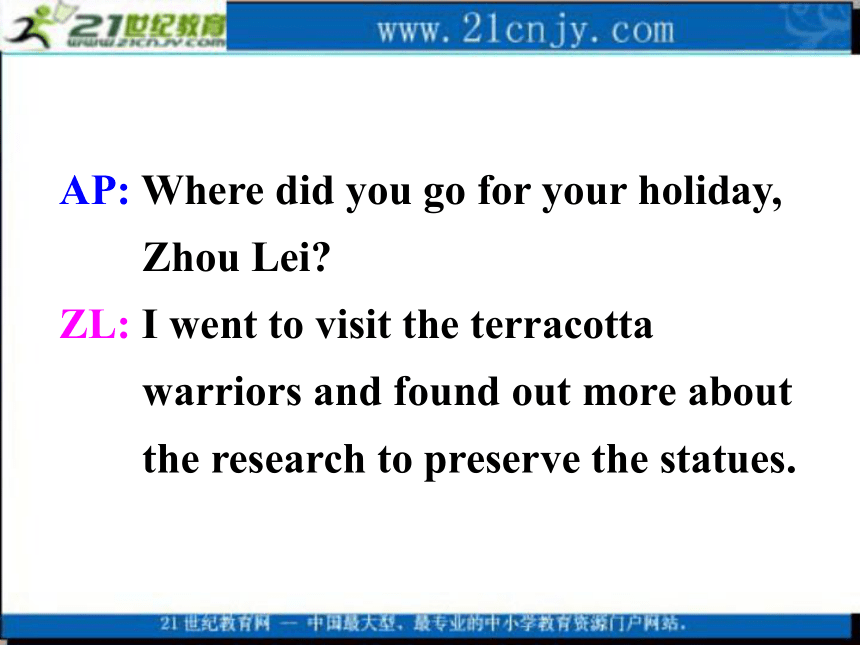
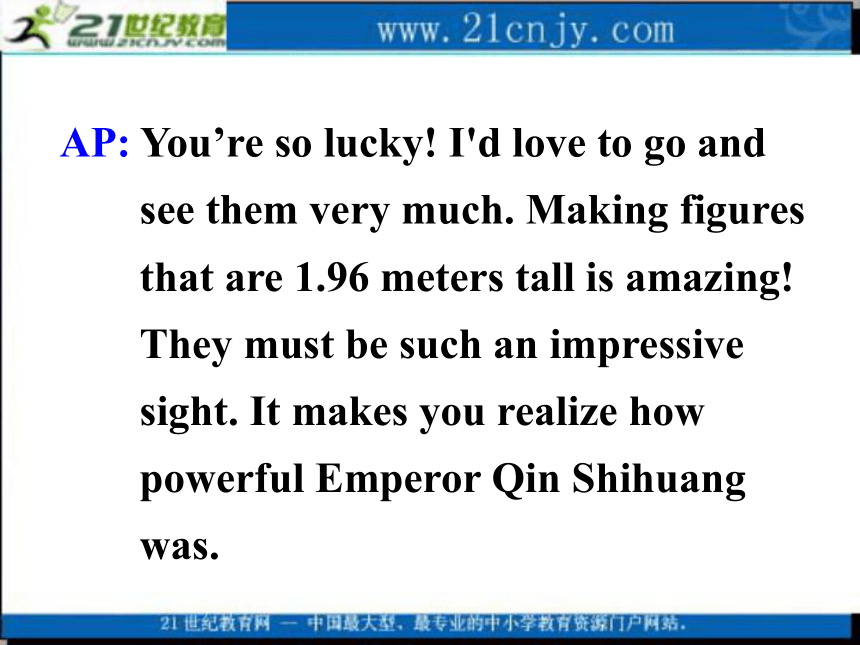
文档简介
课件41张PPT。Listening and Reading1. Listen to the tape and write down the main idea of their dialogue:
The main idea is that there are two problems that archaeologists are trying to solve in order to preserve Terracotta Warriors. One is how to protect the colours and the other is how to protect the statues against moulds.1. What is the first problem? Why is it
easier to solve? 2. Listen again and answer the questions.The first problem is how to protect the
colours originally painted on the
terracotta warriors. This problem is
easier to solve because the scientists have
discovered a new chemical protection
which will keep the colors shining brightly.2. How does the terracotta army show
the power of Emperor Qin Shihuang?Each terracotta warrior was a copy of a
real soldier in Qin’s army. It must have
needed a tremendous amout of
organization to produce the number, the
size of the statues and all this shows the
Emperor’s power.3. What caused the terracotta warriors
to lose their colour?The change in temperature and the
sunlight when the warriors were
excavated made them lose their colours.4. Why is it not easy to solve the
problem of forty kinds of mould?The forty kinds of mould are difficult to
treat because they all need different
kinds of treatment.3. Listen to the tape again and fill in the chart below.2,200 years oldclay8,000Individual faces1.96 metres tall1 chemical protectionColor faded2 new treatments being developedGrowth of 40 kinds of mouldMORE NEWS ABOUT
THE TERRACOTFA WARRIORS
Amanda Peter wants to find out about how to preserve the terracotta warriors from her Chinese friend, Zhou Lei (ZL), an archaeologist.LISTENING TEXTAP: Where did you go for your holiday, Zhou Lei?
ZL: I went to visit the terracotta warriors and found out more about the research to preserve the statues.AP: You’re so lucky! I'd love to go and see them very much. Making figures that are 1.96 meters tall is amazing! They must be such an impressive sight. It makes you realize how powerful Emperor Qin Shihuang was.ZL: Yes, indeed. And each of them has an individual face so that archaeologists think they must have been a copy of Qin Shihuang’s real army. But eight thousand statues are a lot of clay figures to protect and there have been problems.
AP: Oh dear! What problems?ZL: Well, the first problem is how to keep their colors. Chinese archaeologists have discovered that the statues were painted before they were buried. But temperature changed and sunlight soon faded the colors after the statues were uncovered.AP: Why did that happen?
ZL: First, some of them became a little bit smaller when they dried out after being excavated and that made their color disappear quickly. Second, the damp in the tomb also affected the colors badly. But now luckily the scientists have discovered a new chemical protection, which will keep the colors shining brightly.
AP: That’s wonderful news.
ZL: Yes. It’s a very thin layer of chemical jelly which will preserve the vivid colors of the soldiers as well as protect them from the damp.AP: That’s great. So the problem’s solved. But I'm afraid that those statues that lost their color can’t get it back?
ZL: Sadly, no. But this breakthrough has helped deal with another problem.
AP: What's that?ZL: Well, you know that the terracotta warriors were discovered in 1974. Since then the statues have suffered more than forty different kinds of mould all caused by damp.AP: That sounds really serious. I didn’t know clay statues could suffer from mould! Did it happen before they were excavated or after?
ZL: After they were excavated, damp entered the excavation area. The moulds developed quickly and need different kinds of treatment.AP: Oh, how terrible! Can we do something to clean the warriors and make them safe?
ZL: Well, this jelly will help protect them against some moulds.
AP: Oh! Is there anything else that ordinary people can do to help? ... (fade out)Answer key for Exercise 1:
I think the ancient Egyptians believed: the spirit of one's body went on the journey to the afterlife. They believed everyone must be tested to see if they had led a good life.Listening on Page 811. Poor people did not bury their dead family members with goods.
2. Both rich and poor people preserved the bodies of their family members after death.FTTrue or False3. The ancient Egyptians believed the spirits of dead people went to the afterlife.
4. The ancient Egyptians believed everyone was first tested to see if they had lived a good life.
5. If you had not lived a good life, you went into the afterlife anyway.FTT6. The God Anubis (埃及神话中导引亡灵之神) ate your spirit if you had led a bad life on the earth.T1. What two things are the same in the two graves?
① Some goods.
② Food for the journey to the afterlife. Answer the following questions after the second-time listening.2. What two things are different?
① Many more goods in the rich person’s grave.
② Body was preserved artificially in a coffin in the rich grave and naturally in the sand in the poor grave. 3. Why did one person take so many artifacts and the other so few?
Because a rich person had many more goods to take with him / her than a poor person.
4. What kind of life did the rich person want in the afterlife?
The same as in his lifetime. Now write down the similarities and differences between the beliefs of rich and poor people.1. They both believed in life after death.1. There were many more goods in the rich person's grave than in the poor person's grave.2. They both had their bodies preserved. 2. The rich person was buried in a special building but the poor person was not.3. They both had goods in the grave for the journey to the afterlife. 3. The rich person had help for the journey to the afterlife but the poor person did not. INTERVIEWING
“THE FATHER OF ARCHAEOLOGY”
Wang Wei, a Chinese student is interviewing Professor Flinders Petrie about his work in Egypt.LISTENING TASK WW: Hello, Professor Petrie. Could you please tell me why you want to dig poor archaeological sites in Egypt instead of looking for new tombs of Egyptian pharaohs? FP: I suppose it was an accident really. When I went there most people were looking for new tombs of the pharaohs. I decided to investigate the life of poorer people as nobody else seemed interested in them!
WW: What sorts of things did you find out? FP: What I found was that poorer people built their houses with mud bricks. They used pottery for their cooking and storing things. I also found that poor people as well as rich people believed in a life after death. They buried their dead family members in the sand with pots full of food ready to take on the journey to the afterlife.
WW: They also wanted to preserve the bodies very well. Why's that? FP: Because they believed the spirit of one's body went on the journey to the afterlife. So it was important to look after the body carefully after one was dead.
WW: Did you find out anything about this journey?FP: Not from the poorer people’s graves. But we found the journey painted on the walls of the pyramids of the pharaohs and the inside of the coffins of rich Egyptians. Later rich people described this journey in books they left in coffins. They are called “The Book of the Dead” and although they were written in rolls of paper, you can still see them today. They tell you how to overcome evil gods and monsters on the journey to the afterlife and what to expect when you came to the Hall of Judgement.WW: Was there a test of some kind?
FP: Yes, you had to prove the quality of your life by weighing your heart against a feather. If your heart was lighter, it meant you had led a good life, and so you could enter the afterlife and live forever. But if it was not, you’d be eaten by the God Anubis and disappear forever.
WW: My goodness. I'm sure that made people behave themselves... (fade out)1. Do some reading on P82.
2. Try to work out the answers to the questions in Ex.2, P83.Homework
The main idea is that there are two problems that archaeologists are trying to solve in order to preserve Terracotta Warriors. One is how to protect the colours and the other is how to protect the statues against moulds.1. What is the first problem? Why is it
easier to solve? 2. Listen again and answer the questions.The first problem is how to protect the
colours originally painted on the
terracotta warriors. This problem is
easier to solve because the scientists have
discovered a new chemical protection
which will keep the colors shining brightly.2. How does the terracotta army show
the power of Emperor Qin Shihuang?Each terracotta warrior was a copy of a
real soldier in Qin’s army. It must have
needed a tremendous amout of
organization to produce the number, the
size of the statues and all this shows the
Emperor’s power.3. What caused the terracotta warriors
to lose their colour?The change in temperature and the
sunlight when the warriors were
excavated made them lose their colours.4. Why is it not easy to solve the
problem of forty kinds of mould?The forty kinds of mould are difficult to
treat because they all need different
kinds of treatment.3. Listen to the tape again and fill in the chart below.2,200 years oldclay8,000Individual faces1.96 metres tall1 chemical protectionColor faded2 new treatments being developedGrowth of 40 kinds of mouldMORE NEWS ABOUT
THE TERRACOTFA WARRIORS
Amanda Peter wants to find out about how to preserve the terracotta warriors from her Chinese friend, Zhou Lei (ZL), an archaeologist.LISTENING TEXTAP: Where did you go for your holiday, Zhou Lei?
ZL: I went to visit the terracotta warriors and found out more about the research to preserve the statues.AP: You’re so lucky! I'd love to go and see them very much. Making figures that are 1.96 meters tall is amazing! They must be such an impressive sight. It makes you realize how powerful Emperor Qin Shihuang was.ZL: Yes, indeed. And each of them has an individual face so that archaeologists think they must have been a copy of Qin Shihuang’s real army. But eight thousand statues are a lot of clay figures to protect and there have been problems.
AP: Oh dear! What problems?ZL: Well, the first problem is how to keep their colors. Chinese archaeologists have discovered that the statues were painted before they were buried. But temperature changed and sunlight soon faded the colors after the statues were uncovered.AP: Why did that happen?
ZL: First, some of them became a little bit smaller when they dried out after being excavated and that made their color disappear quickly. Second, the damp in the tomb also affected the colors badly. But now luckily the scientists have discovered a new chemical protection, which will keep the colors shining brightly.
AP: That’s wonderful news.
ZL: Yes. It’s a very thin layer of chemical jelly which will preserve the vivid colors of the soldiers as well as protect them from the damp.AP: That’s great. So the problem’s solved. But I'm afraid that those statues that lost their color can’t get it back?
ZL: Sadly, no. But this breakthrough has helped deal with another problem.
AP: What's that?ZL: Well, you know that the terracotta warriors were discovered in 1974. Since then the statues have suffered more than forty different kinds of mould all caused by damp.AP: That sounds really serious. I didn’t know clay statues could suffer from mould! Did it happen before they were excavated or after?
ZL: After they were excavated, damp entered the excavation area. The moulds developed quickly and need different kinds of treatment.AP: Oh, how terrible! Can we do something to clean the warriors and make them safe?
ZL: Well, this jelly will help protect them against some moulds.
AP: Oh! Is there anything else that ordinary people can do to help? ... (fade out)Answer key for Exercise 1:
I think the ancient Egyptians believed: the spirit of one's body went on the journey to the afterlife. They believed everyone must be tested to see if they had led a good life.Listening on Page 811. Poor people did not bury their dead family members with goods.
2. Both rich and poor people preserved the bodies of their family members after death.FTTrue or False3. The ancient Egyptians believed the spirits of dead people went to the afterlife.
4. The ancient Egyptians believed everyone was first tested to see if they had lived a good life.
5. If you had not lived a good life, you went into the afterlife anyway.FTT6. The God Anubis (埃及神话中导引亡灵之神) ate your spirit if you had led a bad life on the earth.T1. What two things are the same in the two graves?
① Some goods.
② Food for the journey to the afterlife. Answer the following questions after the second-time listening.2. What two things are different?
① Many more goods in the rich person’s grave.
② Body was preserved artificially in a coffin in the rich grave and naturally in the sand in the poor grave. 3. Why did one person take so many artifacts and the other so few?
Because a rich person had many more goods to take with him / her than a poor person.
4. What kind of life did the rich person want in the afterlife?
The same as in his lifetime. Now write down the similarities and differences between the beliefs of rich and poor people.1. They both believed in life after death.1. There were many more goods in the rich person's grave than in the poor person's grave.2. They both had their bodies preserved. 2. The rich person was buried in a special building but the poor person was not.3. They both had goods in the grave for the journey to the afterlife. 3. The rich person had help for the journey to the afterlife but the poor person did not. INTERVIEWING
“THE FATHER OF ARCHAEOLOGY”
Wang Wei, a Chinese student is interviewing Professor Flinders Petrie about his work in Egypt.LISTENING TASK WW: Hello, Professor Petrie. Could you please tell me why you want to dig poor archaeological sites in Egypt instead of looking for new tombs of Egyptian pharaohs? FP: I suppose it was an accident really. When I went there most people were looking for new tombs of the pharaohs. I decided to investigate the life of poorer people as nobody else seemed interested in them!
WW: What sorts of things did you find out? FP: What I found was that poorer people built their houses with mud bricks. They used pottery for their cooking and storing things. I also found that poor people as well as rich people believed in a life after death. They buried their dead family members in the sand with pots full of food ready to take on the journey to the afterlife.
WW: They also wanted to preserve the bodies very well. Why's that? FP: Because they believed the spirit of one's body went on the journey to the afterlife. So it was important to look after the body carefully after one was dead.
WW: Did you find out anything about this journey?FP: Not from the poorer people’s graves. But we found the journey painted on the walls of the pyramids of the pharaohs and the inside of the coffins of rich Egyptians. Later rich people described this journey in books they left in coffins. They are called “The Book of the Dead” and although they were written in rolls of paper, you can still see them today. They tell you how to overcome evil gods and monsters on the journey to the afterlife and what to expect when you came to the Hall of Judgement.WW: Was there a test of some kind?
FP: Yes, you had to prove the quality of your life by weighing your heart against a feather. If your heart was lighter, it meant you had led a good life, and so you could enter the afterlife and live forever. But if it was not, you’d be eaten by the God Anubis and disappear forever.
WW: My goodness. I'm sure that made people behave themselves... (fade out)1. Do some reading on P82.
2. Try to work out the answers to the questions in Ex.2, P83.Homework
